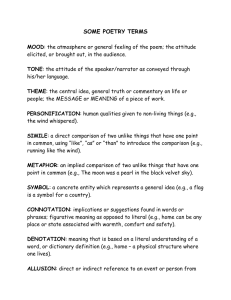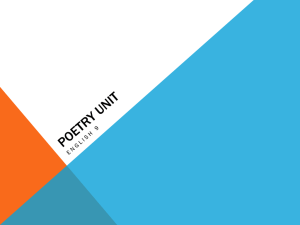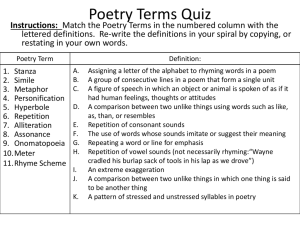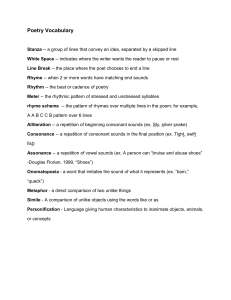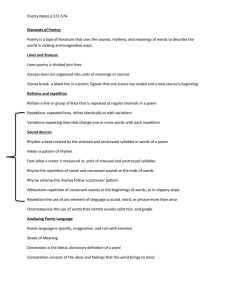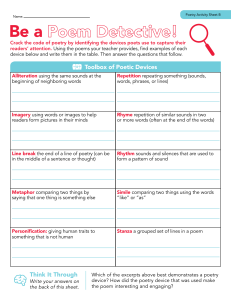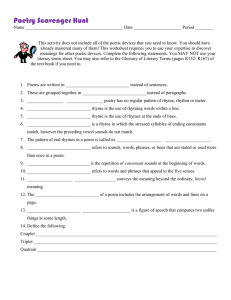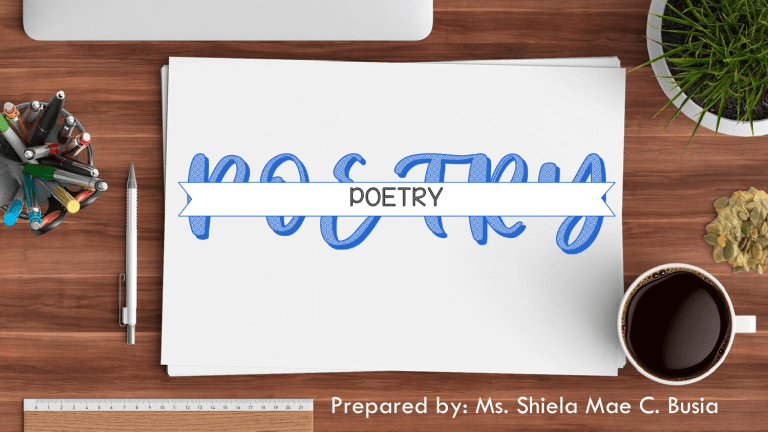
POETRY Prepared by: Ms. Shiela Mae C. Busia ELEMENTS OF POETRY 2 An important method of analyzing a poem is to look at the stanza structure or style of a poem. Generally speaking, structure has to do with the overall organization of lines and/or the conventional patterns of sound. Again, many modern poems may not have any identifiable structure (i.e. they are free verse), so don't panic if you can't find it! 3 STANZAS Stanzas are a series of lines grouped together and separated by an empty line from other stanzas. They are the equivalent of a paragraph in an essay. One way to identify a stanza is to count the number of lines. Thus: 4 •couplet (2 lines) •tercet (3 lines) •quatrain (4 lines) •cinquain (5 lines) •sestet (6 lines) •(sometimes it's called a sexain) •septet (7 lines) •octave (8 lines) 5 FORM A poem may or may not have a specific number of lines, rhyme scheme and/or metrical pattern, but it can still be labeled according to its form or style. 6 SOUND PATTERNS Three other elements of poetry are rhyme scheme, meter (ie. regular rhythm) and word sounds (like alliteration). These are sometimes collectively called sound play because they take advantage of the performative, spoken nature of poetry. 7 WORD SOUNDS Common types of sound play emphasize individual sounds between and within words: 8 Alliteration > the repetition of initial sounds on the same line or stanza Big bad Bob bounced bravely. 9 LET’S TRY THIS TONGUE TWISTER! > Peter Piper picked a peck of pickled peppers. If Peter > > Piper picked a peck of pickled peppers, where's the peck of pickled peppers Peter Piper picked? How much wood would a woodchuck chuck; If a woodchuck would chuck wood? A woodchuck would chuck all the wood he could chuck; If a woodchuck would chuck wood. A good cook could cook as much cookies as a good cook who could cook cookies. 10 Assonance > the repetition of vowel sounds (anywhere in the middle or end of a line or stanza) - Tilting at windmills 11 EXAMPLES • "Hear the mellow wedding bells" by Edgar Allen • • • Poe. "Try to light the fire" "I lie down by the side for my bride"/"Fleet feet sweep by sleeping geese"/"Hear the lark and harken to the barking of the dark fox gone to ground" by Pink Floyd. "It's hot and it's monotonous." by Sondheim. 12 Consonance > the repetition of consonant sounds (anywhere in the middle or end of a line or stanza) - And all the air a solemn stillness holds. (T. Gray) 13 EXAMPLES • • • • • • Mike likes his new bike. I will crawl away the ball. He stood on the road and cried. Toss the glass, boss. It will creep and beep while you sleep. He struck a streak of bad luck. 14 Onomatopoeia > words that sound like that which they describe - Boom! Crash! Pow! Quack! Moo! Caress... 15 EXAMPLES • The sheep went, “Baa.” • The best part about music class is that you can • • • bang on the drum. It is not unusual for a dog to bark when visitors arrive. Silence your cellphone so that it does not beep during the movie. Dad released a belch from the pit of his stomach. 16 Repetition > the repetition of entire lines or phrases to emphasize key thematic ideas. 17 EXAMPLES > Let it snow, let it snow, let it snow. > "Oh, woeful, oh woeful, woeful, woeful day! > --Shakespeare, Romeo and Juliet > "And miles to go before I sleep, and miles to go before I sleep." > --Robert Frost "Stopping by Woods on a Snowy Evening" 18 Parallel Stucture > : a form of repetition where the order of verbs and nouns is repeated; it may involve exact words, but it more importantly repeats sentence structure - "I came, I saw, I conquered". 19 RHYME Rhyme is the repetition of similar sounds. In poetry, the most common kind of rhyme is the end rhyme, which occurs at the end of two or more lines. It is usually identified with lower case letters, and a new letter is used to identify each new end sound. Take a look at the rhyme scheme for the following poem : 20 21 EXAMPLES I saw a fairy in the wood, He was dressed all in green. He drew his sword while I just stood, And realized I'd been seen. 22 A B A B LET’S TRY! The fallen leaves are cornflakes That fill the lawn’s wide fish And night and noon The wind’s a spoon That stirs them with a swish 23 A B C C B Internal rhyme > occurs in the middle of a line, as in these lines from Coleridge, "In mist or cloud, on mast or shroud" or "Whiles all the night through fog-smoke white" ("The Ancient Mariner"). Remember that most modern poems do not have rhyme. 24 EXAMPLES • I went to town to buy a gown. / I took the car and it wasn't far. • Once upon a midnight dreary, while I pondered, weak and weary - Edgar Allen Poe (The Raven). • I had a cat who wore a hat. / He looked cool but felt the fool. 25 MOOD The feeling that a poem creates in a reader. It can be positive or negative. 26 TONE It is the attitude a writer takes towards the subject or audience of the pattern. 27 IMAGERY Language that appeals to the 5 senses. It helps the reader to experience familiar things in a fresh way using the senses. 28 THEME The theme of a poem is its central or main idea. 29 LET’S TRY 30 What is the rhyme scheme? > > > > True friends are by your side Through it all True friends are there To catch you when you fall - - A B C B What Element of Poetry? What Element of Poetry? > “Its okay not to be okay.” What Element of Poetry? > The flood water gushed through the town. What Element of Poetry? > Let it go, let it go cant hold back anymore. What Element of Poetry? > On scrolls of silver snowy sentences What Element of Poetry? > The corn went pop in the microwave. What Element of Poetry? > Dragging the lazy languid line along. What Element of Poetry? Fair is foul, and foul is fair Hover through the fog and filthy air. > What Element of Poetry? > Round and round the rugged rocks the ragged rascal ran. Thanks! Any questions? Find me at busia.shielamae@spcc.edu.ph 41
